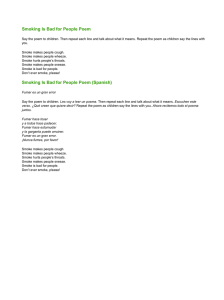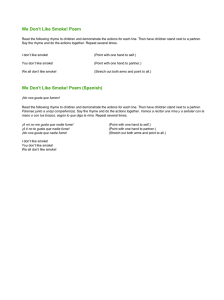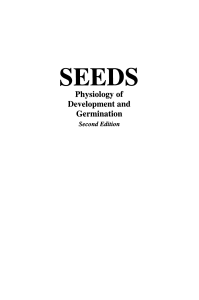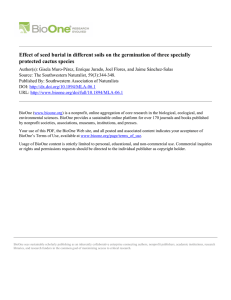Effect of cold storage, heat, smoke and charcoal on breaking seed
Anuncio
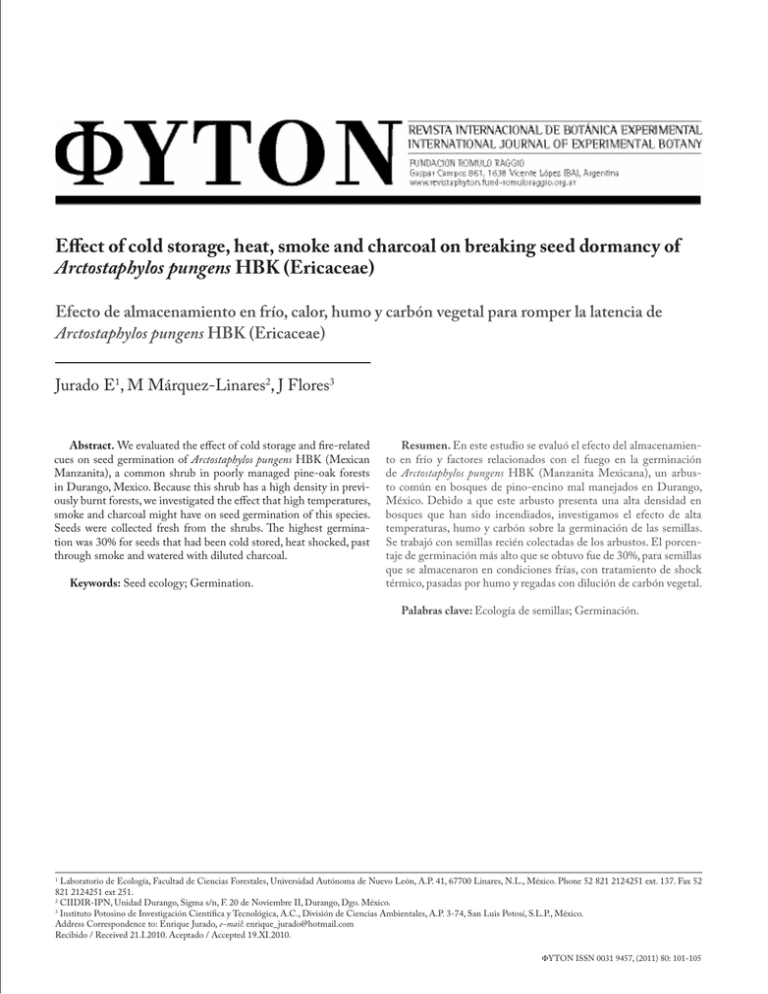
Effect of cold storage, heat, smoke and charcoal on breaking seed dormancy of Arctostaphylos pungens HBK (Ericaceae) Efecto de almacenamiento en frío, calor, humo y carbón vegetal para romper la latencia de Arctostaphylos pungens HBK (Ericaceae) Jurado E1, M Márquez-Linares2, J Flores3 Abstract. We evaluated the effect of cold storage and fire-related cues on seed germination of Arctostaphylos pungens HBK (Mexican Manzanita), a common shrub in poorly managed pine-oak forests in Durango, Mexico. Because this shrub has a high density in previously burnt forests, we investigated the effect that high temperatures, smoke and charcoal might have on seed germination of this species. Seeds were collected fresh from the shrubs. The highest germination was 30% for seeds that had been cold stored, heat shocked, past through smoke and watered with diluted charcoal. Keywords: Seed ecology; Germination. Resumen. En este estudio se evaluó el efecto del almacenamiento en frío y factores relacionados con el fuego en la germinación de Arctostaphylos pungens HBK (Manzanita Mexicana), un arbusto común en bosques de pino-encino mal manejados en Durango, México. Debido a que este arbusto presenta una alta densidad en bosques que han sido incendiados, investigamos el efecto de alta temperaturas, humo y carbón sobre la germinación de las semillas. Se trabajó con semillas recién colectadas de los arbustos. El porcentaje de germinación más alto que se obtuvo fue de 30%, para semillas que se almacenaron en condiciones frías, con tratamiento de shock térmico, pasadas por humo y regadas con dilución de carbón vegetal. Palabras clave: Ecología de semillas; Germinación. Laboratorio de Ecología, Facultad de Ciencias Forestales, Universidad Autónoma de Nuevo León, A.P. 41, 67700 Linares, N.L., México. Phone 52 821 2124251 ext. 137. Fax 52 821 2124251 ext 251. 2 CIIDIR-IPN, Unidad Durango, Sigma s/n, F. 20 de Noviembre II, Durango, Dgo. México. 3 Instituto Potosino de Investigación Científica y Tecnológica, A.C., División de Ciencias Ambientales, A.P. 3-74, San Luis Potosí, S.L.P., México. Address Correspondence to: Enrique Jurado, e-mail: enrique_jurado@hotmail.com Recibido / Received 21.I.2010. Aceptado / Accepted 19.XI.2010. 1 FYTON ISSN 0031 9457, (2011) 80: 101-105 102 INTRODUCTION In ecosystems adapted to fire, two main strategies can be found for plant reproduction. These strategies include heat resisting (often underground) structures, and heat resistant seeds (Keeley, 1991). Arctostaphylos is a genus with 150 species, many of which inhabit fire-prone ecosystems like chaparrals, and cold and temperate forests (Berg, 1974; Weise et al., 1991). Species in this genus can survive fire as adult plants or germinate after fire (Weise et al., 2005). For seeds that germinate after fire, several factors can trigger germination or break dormancy: heat (Álvarez et al., 2007; Luna et al., 2007; Paula & Pausas, 2008); smoke (Brown, 1992; Keeley & Fotheringham, 1997; Flematti et al., 2004; Crosti et al., 2006; Tieu et al., 1999); charred wood residues (Brown, 1992; Pérez-Fernández & Rodríguez-Echeverría, 2003), or a combination of them (Thomas et al., 2003, 2007; Gilmour et al., 2000). Other factors such as late seed maturation (after-ripening), and over-wintering can influence germination of plants from temperate environments (Baskin and Baskin, 1998). Mexican Manzanita (Arctostaphylos pungens HBK) is a widespread shrub common to pine and pine oak forests and chaparrals in Southern United States and Mexico (MárquezLinares et al., 2005a). This species has some medicinal use in Mexico (González-Elizondo, 1984; Bye, 1986), and is used as ornamental in California (Márquez-Linares et al., 2005c). Its establishment occurs after fire under natural conditions, although natural fire regimes are poorly understood (Rzedowsky, 1978; Casas et al., 1995; Fulé et al., 2000; Márquez-Linares et al., 2005a,b). Seeds of Arctostaphylos resemble a small nut from 1 to 3 mm length with 3 to 7 seeds and a hard endocarp.While the mesocarp is edible, the exocarp is a thin paper-like structure. Seeds are water permeable; however, seed germination of this genus is not clearly understood, since it does not germinate in contact with water (Bliss, 1958; Berg, 1974). Seeds from Arctostaphylos pungens have none or very low germination (Martínez-Pérez et al., 2006) even after applying conventional treatments such as mechanical scarification, cold storage and different light regimes, and using seeds either from different ages or collected from dung of dispersal agents (Márquez-Linares, 2004). Perhaps variables associated with fire (such as high temperature and smoke) break seed dormancy. However, no studies have investigated the effect of fire on the germination of Mexican Manzanita. We explored whether germination of Arctostaphylos pungens might be induced by cold storage, heat, smoke and charcoal. This would allow to better understand field conditions that might result on the encroachment of this shrub in Durango forests and chaparrals. FYTON ISSN 0031 9457, (2011) 80: 101-105 Jurado E et al., FYTON 80 (2011) MATERIALS AND METHODS Freshly matured seeds of Arctostaphylos pungens were collected from randomly selected plants (n=20) on June 2003 at 2440 m above sea level. Seeds were cleaned in the lab from fruit remains. Seeds that (1) were malformed, (2) had insect perforations, and (3) were not easy to separate were discarded. Clean selected seeds were placed in water for one minute, and those that floated were considered unviable and discarded. A set of seeds was tested for viability using the tetrazolium test (Sutherland, 1998). Extra seeds were added so the number used for germination included at least 50 viable seeds per replicate. Seeds were placed inside Petri dishes with filter paper. Cotton wool was placed under the filter paper to keep moisture and prevent excess available water. Seeds were positioned with the hypocotyl facing downward, in contact with the moist filter paper. Petri dishes were plastic sealed to keep moisture, and incubated at 20 °C. An emerging radicle was the indicator of a germinated seed. Germination was registered every three days for eight weeks, removing germinated seeds. We tested the effect of (a) Heat at 100 °C and 120 °C: seeds were placed during five minutes inside a muffle furnace with an electronic temperature control. Temperature was set one degree higher than that reported for each trial to allow for cooling while opening the door. Temperature was independently registered (± 1 °C) using a thermometer with the bulb on the top of the seed tray; (b) Cold storage, by placing seeds 40 days at 4 °C; (c) Smoke: leaves and twigs of Mexican Manzanita were charred on a hot metal plate until they ignited without flame. Smoke was captured using an extractor, and directed toward seeds placed on a wire mesh for 5 minutes. Smoke temperature was < 38 °C when reaching the seeds. In this way, smoke effect was not confounded with heat effect, and (d) Smoke residues, where seeds were watered with burnt Mexican Manzanita residues following Keeley and Fotheringham (1998). These residues were obtained after twigs and leaves of Mexican Manzanita were charred on a hot metal plate. Residues were placed in a beaker with distilled water and stirred. After 12 h, this material was filtered using a 2 mm mesh and diluted to 5%. This dilution was used to water seeds inside the Petri dishes. A control group (e) of seeds kept at room temperature was also tested for germination. Four Petri dishes with 50 viable seeds each were used as replicates for each treatment. Statistical analysis. Data were analyzed using a four-way ANOVA. Adjusting for viability, germination results were converted first to percentage, and then arc-sine transformed before ANOVA (GLM, SAS, 1989). Factors breaking dormancy in Arctostaphylos pungens HBK RESULTS DISCUSSION Seed exposure to 100 °C and 120 °C did not influence germination (F = 2.95; d.f. = 2; P = 0.0608). However, more seeds germinated after cold storage (F = 10.33; d.f. = 1; P = 0.0022), contact with smoke (F = 9.81; d.f. = 1; P = 0.0028) and extract of charcoal (F = 10.73; d.f. = 1; P = 0.0018) (Table 1). The interactions of charcoal extract and smoke, smoke and temperature, and those between smoke, temperature and charcoal extract were significant (Table 2). The highest germination occurred for cold-stored seeds that were exposed to smoke and watered with extract of charcoal (Table 1). Table 1. Seed germination of Arctostaphylos pungens HBK (Mexican Manzanita) from a combination of treatments. Germination percentages are the mean from 4 Petri dishes with 50 viable seeds each. Equal lower case letters represent similar means (p>0.05). Tabla 1. Germinación de semillas de Arctostaphylos pungens HBK (Manzanita Mexicana) bajo una combinación de tratamientos. Los porcentajes de germinación son la media de 4 cajas de Petri con 50 semillas viables cada una. Letras iguales representan medias similares (p>0,05). Treatments Smoke no smoke no smoke no smoke no smoke no smoke no smoke no smoke no smoke no smoke Smoke Smoke Smoke Smoke Smoke Smoke Smoke Smoke Smoke Charcoal Storage Heat extract temperature exposure no ambient none no ambient 120 °C no no no yes yes yes yes no no no no no yes yes yes yes 103 ambient 4 °C 4 °C ambient ambient 4 °C 4 °C ambient ambient ambient 4 °C 4 °C ambient ambient 4 °C 4 °C 100 °C 100 °C 120 °C 100 °C 120 °C 100 °C 120 °C none 100 °C 120 °C 100 °C 120 °C 100 °C 120 °C 100 °C 120 °C Germination Mean ± sd (%) 0.0 ± 0.0a 1.1 ± 1.1a 0.0 ± 0.0a 5.7 ± 4.3b 5.7 ± 4.3b 11.4 ± 6.9b 3.4 ± 2.2ab 8.0 ± 4.7b 3.4 ± 2.2ab 2.3 ± 1.3a 1.1 ± 1.1a 8.0 ± 5.1b 8.0 ± 3.9b 8.0 ± 2.2b 4.6 ± 1.9ab 12.6 ± 7.1b 21.7 ± 3.9c 29.7 ± 8.4c Seed germination of A. pungens was promoted by cold storage suggesting an after winter effect on seed germination. This is also the case in other species in temperate environments (Baskin & Baskin, 1998; Jurado & Flores, 2005). Seed germination was higher when using fire related stimuli: e.g., the combination of high temperature, presence of smoke and watering with charcoal. Post-fire germination fire is in agreement with other species in the genus for California. Keeley (1987) found that lixiviates of charred wood promoted seed germination of several California Chaparral species, including A. glandulosa and A. patula. He argued that germination is promoted by the presence of an oligosaccharide that results from heating hemicelluloses during mild fires; however; it has recently been found that germination is promoted by active butenolide present in plant-derived smoke (Flematti et al., 2004; Merritt et al., 2006; Daws et al., 2007; Stevens et al., 2007). Parker & Kelly (1989) found that seeds of A. canescens extracted from the soil germinated when watered with charred wood extract. The effect of smoke promoting germination has not been determined for Arctostaphylos, but it has been shown to promote seed permeability in several species of the Californian Chaparral (Keeley & Fotheringham, 1998). Heat did not stimulate germination by itself either for A. viscida and A. mewukka (Kauffman, 1986; Kauffman & Martin, 1991) or for A. patula and A. glandulosa (Keeley, 1987). We found that several factors combined increased germination percentage of Mexican Manzanita seeds. This suggests a synergic effect in the combination of variables such as cold storage, smoke, and heat and charcoal. However, germination was relatively low (ca. 30%) even with a combination of cold storage and fire-simulating variables. It is possible that other factors such as fluctuating light regimes (Baskin & Baskin, 1998; Pons, 2000; Flores et al., 2006) might promote germination. However, it is also possible that only very few seeds of Mexican Manzanita germinate each year after winter, like other temperate climate species that form a seed bank ( Jurado & Flores, 2005; Ibáñez et al., 2007). However, after a fire many seeds would germinate, like those from fire-adapted species (Álvarez et al., 2007; Luna et al., 2007; Paula & Pausas, 2008). The cold storage conditions, and the conditions made to simulate fire such as heat, smoke and charcoal used here, might have been only similar to natural winter temperature variations in the field, and the effects of a real fire. However, they were sufficient to trigger germination on a relatively small percentage of seeds. Further experiments manipulating the variables tested here, and others, might help to determine the natural conditions that trigger establishment of large numbers of Mexican Manzanita seedlings in Durango Forests and Chaparrals. FYTON ISSN 0031 9457, (2011) 80: 101-105 104 Jurado E et al., FYTON 80 (2011) Table 2. Analysis of Variance on seed germination of Arctostaphylos pungens HBK (Mexican Manzanita) from a combination of treatments. Tabla 2. Análisis de Varianza de la germinación de semillas de Arctostaphylos pungens HBK (Manzanita Mexicana) de una combinación de tratamientos. Source Degrees of Freedom Sum of Squares Mean Square Error 54 0.10551239 0.00195393 Model Total Storage Heat Smoke Charcoal Storage*Heat Storage*Smoke Storage*Charcoal Heat*Smoke Heat*Charcoal Smoke*Charcoal Storage*Heat*Smoke Storage*Smoke*Charcoal Heat*Smoke*Charcoal Storage*Heat*Smoke*Charcoal 17 71 1 2 1 1 2 1 1 1 1 1 1 1 1 2 0.12762550 0.23313789 P 3.84 0.0001 0.02018976 0.02018976 10.33 0.0022 0.01915981 0.01915981 9.81 0.0028 0.01152765 0.02095787 0.00132886 0.01145559 0.00256729 0.01283446 0.00004554 0.00483963 0.00188936 0.01583716 0.00482305 0.00016949 ACKNOWLEDGEMENTS This research was partially supported by PAICYT CN156607. REFERENCES Álvarez, R., l. Valbuena & l. Calvo (2007)������������������������� . ����������������������� Effect of high temperatures on seed germination and seedling survival in three pine species (Pinus pinaster, P. sylvestris and P. nigra). International Journal of Wildland Fire 16: 63-70. Baskin, C.C. & J.M. Baskin (1998). Germination ecology of seeds with physical dormancy. In: C.C. Baskin, J.M. Baskin (Eds.). Seeds: Ecology, Biogeography, and Evolution of Dormancy and Germination. pp. 5 - 42. Academic Press, San Diego. Berg, A.R. (1974). Arctostaphylos Adans. In: C.S. Schopmeyer (Ed). Seeds of woody plants in the United States. pp. 228-231. Agricultural Handbook. USDA Forest Service, Washington, D.C. Bliss, L.C. (1958). Seed germination in arctic and alpine species. Arctic 11: 180-188. Brown, N.A.C. (1992). Seed germination in the fynbos fire ephemeral, Syncarpha vestita (L) B-Nord is promoted by smoke, aqueous extracts of smoke and charred wood derived from burning the ericoid-leaved shrub, Passerina vulgaris Thoday. International Journal of Wildland Fire 3: 203-206. Bye, R. (1986). Medicinal Plants of the Sierra Madre: Comparative study of Tarahumara and Mexican market plants. Economic Botany 40: 103-124. FYTON ISSN 0031 9457, (2011) 80: 101-105 0.00750738 F 0.00576382 0.02095787 0.00066443 0.01145559 0.00256729 0.01283446 0.00004554 0.00483963 0.00188936 0.01583716 0.00482305 0.00008474 2.95 10.73 0.34 5.86 1.31 6.57 0.02 2.48 0.97 8.11 2.47 0 .04 0.0608 0.0018 0.7133 0.0189 0.2567 0.0132 0.8792 0.1214 0.3298 0.0062 0.1220 0.9576 Casas, R., S. González & J. Tena (1995). Estructura y tendencias sucesionales en vegetación de clima templado semi-seco en Durango, México. Madroño 42: 501-515. Crosti, R., P.G. Ladd, K.W. Dixon & B. Piotto (2006). Post-fire germination: The effect of smoke on seeds of selected species from the central Mediterranean Basin. Forest Ecology and Management 221: 306-312. Daws, M.I., J. Davies, H.W. Pritchard, N.A.C. Brown & J. Van Staden (2007). Butenolide from plant-derived smoke enhances germination and seedling growth of arable weed species. Plant Growth Regulation 51: 73-82. Flematti, G.R., E.L. Ghisalberti, K.W. Dixon & R.D. Trengove (2004). A compound from smoke that promotes seed germination. Science 305: 977. Flores, J., E. Jurado & A. Arredondo (2006). Effect of light on germination of seeds of Cactaceae from the Chihuahuan Desert, México. Seed Science Research 16: 149–155. Fulé, P.Z., A. García-Arévalo & W.W. Covington (2000). Effects of an intense wildfire in a Mexican Oak-Pine forest. Forest Science 46: 52-61. Gilmour, C.A., R.K. Crowden & A. Koutoulis (2000). Heat shock, smoke and darkness: partner cues in promoting seed germination in Epacris tasmanica (Epacridaceae). Australian Journal of Botany 48: 603-609. González-Elizondo, M. (1984). Las plantas medicinales de Durango. Inventario básico. Cuadernos de Investigación Tecnológica, CIDIIR-IPN 1: 1-115. Ibáñez, I., J.S. Clark, S. Ladeaus, J. Hille & R. Lambers (2007). Exploiting temporal variability to understand tree recruitment response to climate change. Ecological Monographs 77: 163-177. Jurado, E. & J. Flores (2005). Is seed dormancy under environmental control or bound to plant traits? Journal of Vegetation Sciences 16: 559-564. Factors breaking dormancy in Arctostaphylos pungens HBK Kauffman, J.B. (1986). The ecological response of the shrub component to prescribed burning in a mixed conifer ecosystems. Ph.D. Dissertation. University of California, Berkeley. USA. Kauffman, J.B. & R.E. Martin (1991). Factors influencing the scarification and germination of three montane Sierra Nevada shrubs. Northwest Science 65: 180-187. Keeley, J.E. (1987). Role of fire in seed germination of woody taxa in California chaparral. Ecology 68: 434-443. Keeley, J.E. (1991). Seed germination and life history syndromes in the California chaparral. Botanical Review 57: 81-116. Keeley, J.E. & C.J. Fotheringham (1997). Trace gas emissions and smoke-induced seed germination. Science 276: 1248-1250. Keeley, J.E. & C.J. Fotheringham (1998). Smoke-induced seed germination in California Chaparral. Ecology 79: 2320-2336. Luna, B., J.B. Moreno, A. Cruz & F. Fernández-González (2007). Heatshock and seed germination of a group of Mediterranean plant species growing in a burning area: An approach based plant functional types. Environmental and Experimental Botany 60: 324-333. Márquez-Linares, M.A (2004). Distribution, germination and population structure of Arctostaphylos pungens HBK, and their relation with fire in Durango Mexico. Ph.D. Dissertation. University of Nuevo Leon, Mexico. Márquez-Linares, M.A., E. Treviño-Garza & E. Jurado (2005a). Reemplazo de áreas arboladas por chaparrales y comunidades herbáceas en el periodo 1970-2000 en una microcuenca de Durango, México. Investigaciones Geográficas 58: 54-65. Márquez-Linares, M.A., E. Jurado & C. López-González (2005b). Efecto del fuego en el establecimiento de Arctostaphylos pungens HBK., en ecosistemas templados semihúmedos de Durango, México. Madera y Bosques 11: 35-48. Márquez-Linares, M.A., E. Jurado & S. González-Elizondo (2005c). Algunos aspectos de la biología de la manzanita (Arctostaphylos pungens HBK.) y su papel en el desplazamiento de bosques templados por chaparrales. Revista Ciencia UANL 9: 57-64. Martínez-Pérez, G., A. Orozco-Segovia & C. Martorell (2006). Efectividad de algunos tratamientos pre-germinativos para ocho especies leñosas de la Mixteca Alta Oaxaqueña con características relevantes para la restauración. Boletín de la Sociedad Botánica de México 79: 9-20. Merritt, D.J., M Kristiansen, G.R. Flematti, S.R. Turnera, E.L. Ghisalbertia, R.D. Trengovea & K.W. Dixon (2006). Effects of a butenolide present in smoke on light-mediated germination of Australian Asteraceae. Seed Science Research 16: 29-35. Parker, V.T. & V.R. Kelly (1989). Seed bank in California chaparral and other Mediterranean climate shrublands. In: Leck M.A. & R.L. Simpson (Eds.). Ecology of soil seed banks. Academic Press. San Diego. pp. 231-253. Paula, S. & J.G. Pausas (2008). Burning seeds: germinative response to treatments in relation to resprouting ability. Journal of Ecology 96: 43-52. Pérez-Fernández, M.A. & S. Rodríguez-Echeverría (2003). Effect of smoke, charred wood and nitrogenous compounds on seed germination of ten species from woodland in Central-Western Spain. Journal of Chemical Ecology 29: 237-251. Pons, T.L. (2000). Seed responses to light. In: Fenner M. (Ed.) Seeds: The ecology of regeneration in plant communities. 2nd edition. CABI Publishing. Wallingford. pp. 237–260. Rzedowski, J. (1978). La vegetación de México. Ed. Limusa, México D. F. 105 SAS Institute Inc (1998). SAS/STAT Users´Guide, Relase 6.03. SAS Institute, Cary, N.C. USA. Stevens, J.C., D.J. Merritt, G.R. Flematti, E.L. Ghisalberti & K.W. Dixon (2007). Seed germination of agricultural weeds is promoted by the butenolide 3-methyl-2 H -furo[2,3- c ]pyran-2-one under laboratory and field conditions. Plant and Soil 298: 113-124. Sutherland, W.J. (1998). Ecological census techniques: A handbook. Cambridge University Press, London. Thomas, P.B., E.C. Morris & T.D. Auld (2003). Interactive effects of heath shock and smoke on germination of nine species forming soil seed banks within the Sydney region. Austral Ecology 28: 674-683. Thomas, P.B., E.C. Morris & T.D. Auld (2007). Response surfaces for the combined effects of heat shock and smoke on germination of 16 species forming soil seed banks in south-east Australia. Austral Ecology 32: 605-616. Tieu, A., J.A. Plummer, K.A. Dixon, K. Sivasithamparam & I.M. Sieler (1999). Germination of four species of native Western Australian plants using plant-derived smoke. Australian Journal of Botany 47: 207-219. Weise, D.R., D.E. Ward, T.E. Paysen & A.L. Koonce (1991). Burning California Chaparral - an exploratory study of some common shrubs and their combustion characteristics. International Journal of Wildland Fire 1: 153-158. Weise, D.R., Z.B. Xiangyang, S.B. Lulu & S. Mahalingam (2005). Fire spread in chaparral-‘go or no-go?’ International Journal of Wildland Fire 14: 99-106. FYTON ISSN 0031 9457, (2011) 80: 101-105
